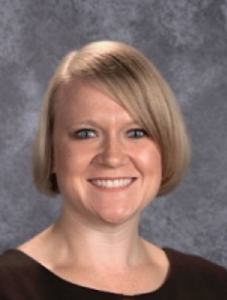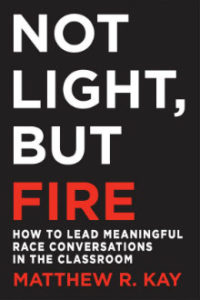Managing Meaningful Classroom Conversations
Not Light, But Fire: How to Lead Meaningful Race Conversations in the Classroom
By Matthew R. Kay
(Stenhouse, 2018 – Learn more)

The thing that I miss the most during the summer break is talking with my students. For me, the best kind of professional development book takes me into a classroom and allows me to sit with the author and his/her students. Not Light, But Fire by Matthew R. Kay is that kind of book.
Kay is a high school English teacher who clearly cares for his students and values discussion. He starts off the book by reminding you that the things you make time for in the classroom are the things that you value. If you value your students sharing their ideas, make it a regular part of your classroom, not something you fit in “if you have time.”
The first conversation of the year

This is how the book starts. You can see what is important to him by what he talks about first in his book. It’s a reminder of all of the things we all want in our classrooms no matter what we teach.
We want our students to know that we care about them. We want them to share their ideas and listen to each other. We want them to make connections on their own. In case you have picked up his book by mistake and aren’t sure it is meant for you, the first part will convince you otherwise.
But what made this book so engaging to read is that he doesn’t just tell you how to do all of these things, he shows you through discussions he has had with his own students. Getting to see all of this play out in a real classroom makes it so much easier to imagine this happening in your own classroom.
You can see that these ideas are possible with real students. And not just some imaginary group of students, but his students. It’s like peeking into his brain while he is teaching.
Taking you into the conversation
Then Kay takes you into the conversation: how to start and end a discussion and how to navigate four kinds of conflict. Again, all of these ideas are grounded around a conversation that he has had with his students, showing how all four types of conflict can look and sound and play out in your classroom. He shows you how he navigated it and learned from it — and he gives suggestions to help you navigate through it as well.
Kay reminds you that it’s not just about students sharing their ideas; it’s about students listening to their classmates’ ideas and looking at these ideas with a critical eye. He reminds you to keep the purpose of the conversation at the forefront of your mind, and to always ground the conversations within the context of what you are learning to make them more meaningful.
If you’re thinking that he sounds too good to be true, he will quickly remind you of all of the mistakes he has made over the years. This book didn’t happen because he is the perfect teacher; this book happened because he is a reflective teacher who saw that he was doing something that was working and thought other teachers could benefit from seeing his successes and missteps. And some of his missteps are just as cringe-worthy as yours.
‘Pop-up” conversations
Throughout the whole book, you can see what a conscientious educator Kay is. He doesn’t do anything that he doesn’t think about, either before or after it happens. He has conversations that he returns to year after year, and he has conversations that he will never have again. He doesn’t like what he calls “pop-up” race conversations: conversations that you feel that you need to have because of something that is going on in the world.
Kay doesn’t tell you to not have these conversations, but just to remember that your students are not your therapists and they are not there to help you figure out what is going on in the world. It is your job to help them make sense of the world and how it connects with what they are already thinking and learning about. But just in case something comes up that you really need to talk about with your students, he gives you some guidelines for that too.
Race conversations
The second part of the book was the most interesting to me. Each chapter looks at one particular race conversation that he has had in his classroom: usage of the n-word, cultural appropriation, names, and the 2016 election (a rare pop-up conversation). You get to see the whole picture: how he prepares for the conversation, how he gets it started, what he says to keep the conversation moving, how his students move the conversation along and the various tangents that they take, what he is thinking about throughout the conversation, and how he wraps it up.
Kay believes it is very important to leave time for reflection at the end of a discussion, no matter how badly you want to wring every last minute out of it. It is good for students to have some time individually and in pairs to think about what really stood out for them in the discussion and what questions they have. This kind of reflection is invaluable for teachers’ planning for tomorrow, whether you are going to pick up the conversation where it left off or take a new direction.
Kay is the very epitome of a reflective educator. If you value student discussion, this book is for you. If you value students working through big issues, this book is for you. I think there is something valuable for teachers of all grades with this thoughtful, engaging book. As he says in the title, and in the introduction that explains it, we are past the point of shedding light on difficult topics — we need fire to make a change.
Andrea Clark (Teaching with Mrs. Clark) teaches 5-6th grade math and language arts at the International School of Texas in Austin. Her favorite subjects to teach are math and writing, so this is the perfect job for her. This summer, she is reading a lot of middle grades books and presenting at the IB World Conference in New Orleans.


































